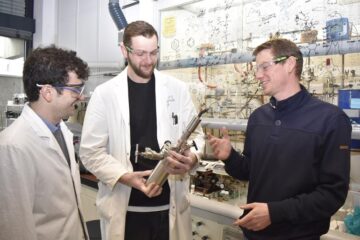Hubble Zooms in on Double Nucleus in Andromeda Galaxy

This is the sharpest visible-light image ever made of the nucleus of an external galaxy.
The event horizon, the closest region around the black hole where light can still escape, is too small to be seen, but it lies near the middle of a compact cluster of blue stars at the center of the image. The compact cluster of blue stars is surrounded by the larger “double nucleus” of M31, discovered with the Hubble Space Telescope in 1992. The double nucleus is actually an elliptical ring of old reddish stars in orbit around the black hole but more distant than the blue stars. When the stars are at the farthest point in their orbit they move slower, like cars on a crowded freeway. This gives the illusion of a second nucleus.
The blue stars surrounding the black hole are no more than 200 million years old, and therefore must have formed near the black hole in an abrupt burst of star formation. Massive blue stars are so short-lived that they would not have enough time to migrate to the black hole if they were formed elsewhere.
Astronomers are trying to understand how apparently young stars were formed so deep inside the black hole’s gravitational grip and how they survive in an extreme environment.
The fact that young stars are also closely bound to the central black hole in our Milky Way galaxy suggests this may be a common phenomenon in spiral galaxies.
Tod R. Lauer of the National Optical Astronomy Observatory in Tucson, Ariz., assembled this image of the nuclear region by taking several blue and ultraviolet light exposures of the nucleus with Hubble’s Advanced Camera for Surveys high-resolution channel, each time slightly moving the telescope to change how the camera sampled the region. By combining these pictures, he was able to construct an ultra-sharp view of the galaxy’s core.
Lauer is presenting these Hubble observations this week at the meeting of the American Astronomical Society in Austin, Texas.
The image of the Andromeda galaxy was taken on Jan. 13, 2001, with the WIYN/KPNO 0.9-meter Mosaic I by T. Rector, University of Alaska in Anchorage.
Ray Villard
Space Telescope Science Institute, Baltimore, Md.
410-338-4514
villard@stsci.edu
Tod R. Lauer
National Optical Astronomy Observatory, Tucson, Ariz.
520-318-8290
lauer@noao.edu
Media Contact
All latest news from the category: Physics and Astronomy
This area deals with the fundamental laws and building blocks of nature and how they interact, the properties and the behavior of matter, and research into space and time and their structures.
innovations-report provides in-depth reports and articles on subjects such as astrophysics, laser technologies, nuclear, quantum, particle and solid-state physics, nanotechnologies, planetary research and findings (Mars, Venus) and developments related to the Hubble Telescope.
Newest articles

Lower dose of mpox vaccine is safe
… and generates six-week antibody response equivalent to standard regimen. Study highlights need for defined markers of mpox immunity to inform public health use. A dose-sparing intradermal mpox vaccination regimen…

Efficient, sustainable and cost-effective hybrid energy storage system for modern power grids
EU project HyFlow: Over three years of research, the consortium of the EU project HyFlow has successfully developed a highly efficient, sustainable, and cost-effective hybrid energy storage system (HESS) that…

Safer alternative for an explosive reaction
The chemical industry has been using a reaction with explosive chemicals for over 100 years – now Mülheim scientists have discovered a safer alternative. The Ritter Group of the Max…





















